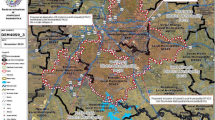Abstract
Why is urban local government failing in many South African secondary cities? Through the example of a major instance of governance collapse in the Emfuleni local municipality, this article discusses the fault lines in the legal and structural architecture underlying governance of South African cities and towns. It argues that, while human failings explain some of the municipality’s failings, there are also deeper problems around municipal demarcation, intergovernmental relations, urban autonomy, and local government financing.
Similar content being viewed by others
References
Atkinson, D. (2007). Taking to the streets: has developmental local government failed in South Africa? In S. Buhlungu et al. (Eds.), State of the nation: South Africa 2007 (pp. 53–77). Pretoria: HSRC Press.
Benit-Gbaffou, C. (2012). Party politics, civil society and local democracy – reflections from Johannesburg. Geoforum, 43(2), 178–189.
Bos, D. J. (1994). Positioning of the Vaal triangle in a new South Africa. Town and Regional Planning, 37(1), 20–28.
Cameron, R. (2005). Metropolitan restructuring (and more restructuring) in South Africa. Public Administration and Development, 25(4), 329–339.
De Visser, J. (2005). Developmental local government: a case study of South Africa. Antwerpen and Oxford: Intersentia.
De Visser, J. (2009). Developmental local government in South Africa; institutional fault lines. Commonwealth Journal of Local Governance, 2009, 7–25.
De Visser, J. (2010). The political-administrative interface in south African municipalities: assessing the quality of local democracies. Commonwealth Journal of Local Governance, 2010, 86–101.
De Visser, J., & November, J. (2017). Overseeing the overseers: assessing compliance with municipal intervention rules in South Africa. Hague Journal of Rule of Law, 9, 103–133.
Democratic Alliance and Another v Masondo and Another. (2002). Decision of the South African Constitutional Court, reported as 2003 (2) SA 413 (CC).
Harrison, P., & Dinath, Y. (2017). Gauteng: on the edge. In Gauteng City region observatory research report no. 6 Uneven spaces: core and periphery in the Gauteng City region (pp. 208–298). Johannesburg, GCRO.
Ledger, T., & Rampedi, M. (2019). Mind the gap: section 139 interventions in theory and practice. Johannesburg: Public Affairs Research Institute.
Marais, L. (2016). Local economic development beyond the centre: reflections on South Africa’s secondary cities. Local Economy, 31(1–2), 68–82.
Marais, L., Lenka, M., Cloete, J., & Grobler, W. (2016a). Emfuleni. In L. Marais et al. (Eds.), Secondary cities and development (pp. 83–100). London: Routledge.
Marais, L., Nel, E., & Donaldson, R. (2016b). The role of secondary cities in South Africa’s development. In L. Marais et al. (Eds.), Secondary cities and development (pp. 159–1178). Routledge: London.
Mathebula, N. E. (2018). Politics of municipal demarcation in the South African democratic dispensation. A case study of selected mergers. African Journal of Public Affairs, 10(4), 257–270.
Oldfield, S. (2008). Participatory mechanisms and community politics: building consensus and conflict. In M. van Donk et al. (Eds.), Consolidating local development: lessons from the South African experience (pp. 487–500). Cape Town: UCT Press.
Palmer, I., Moodley, N., & Parnell, S. (2017). Building a capable state: service delivery in post-apartheid South Africa. London: Zed books.
Pieterse, M. (2019). Urban autonomy in South African intergovernmental relations jurisprudence. Vienna Journal of International Constitutional Law, 13(2), 119–146.
Piper, L., & Deacon, R. (2009). Too dependent to participate: ward committees and local democratisation in South Africa. Local Government Studies, 35(4), 415–433.
Republic of South Africa, Department of Cooperative Government and Traditional Affairs. (2016). Integrated urban development framework.: a new deal for South African cities and towns. Pretoria: COGTA.
Republic of South Africa, National Treasury. (2018). The state of local government finances and financial management. Pretoria: National Treasury.
Savage, D. (2007). Key themes and trends in municipal finance in South Africa. In M. van Donk et al. (Eds.), Consolidating local development: lessons from the South African experience (pp. 284–316). Cape Town: UCT Press.
Slater, D. (2017). Heartland or rustbelt. Engineering News, 37(4), 18–19.
South African Cities Network. (2014). Emfuleni: steeling the river city? SACN: Johannesburg.
South African Municipal Workers Union v Minister for Cooperative Governance and Traditional Affairs. (2017). Decision of the South African Constitutional Court, reported as 2017 (5) BCLR (CC).
Stacey, R. (2018). Falling short of constitutional norms: does ‘normative (in)congruence explain the courts’ inability to promote the right to water in South Africa? Law & Social Inquiry, 43(3), 796–826.
Tempelhoff, J. W. N. (2009). Civil society and sanitation hydropolitics: a case study of South Africa’s Vaal river barrage. Physics and Chemistry of the Earth, 34, 164–175.
Thornhill, C. (2008a). The transformed local government system: some lessons. Journal of Public Administration, 43(3.2), 492–511.
Thornhill, C. (2008b). The executive mayor/municipal manager interface. Journal of Public Administration, 43(4.1), 725–735.
Turok, I. (2014). The resilience of South African cities a decade after local democracy. Environment and Planning A, 46, 749–769.
Woodridge, D. (2007). Political systems and capacity issues. In M. van Donk et al. (Eds.), Consolidating local development: lessons from the South African experience (pp. 465–486). Cape Town: UCT Press.
Author information
Authors and Affiliations
Corresponding author
Additional information
Publisher’s Note
Springer Nature remains neutral with regard to jurisdictional claims in published maps and institutional affiliations.
Rights and permissions
About this article
Cite this article
Pieterse, M. Anatomy of a Crisis: Structural Factors Contributing to the Collapse of Urban Municipal Governance in Emfuleni, South Africa. Urban Forum 32, 1–15 (2021). https://doi.org/10.1007/s12132-020-09406-4
Published:
Issue Date:
DOI: https://doi.org/10.1007/s12132-020-09406-4




